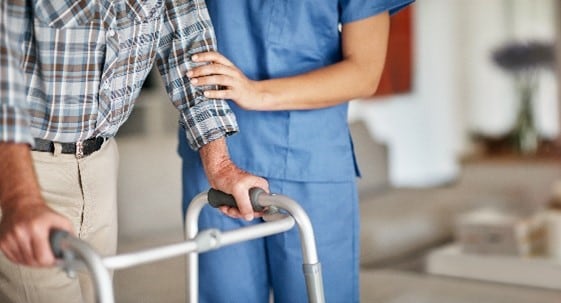Interim Guidance for Infection Control Within Healthcare Settings When Caring for Confirmed Cases, Probable Cases, and Cases Under Investigation for Infection with Novel Influenza A Viruses Associated with Severe Disease
For information on the most recent avian influenza developments specific to the United States, please visit the Current Situation Summary page.

This guidance provides recommendations for infection prevention and control in healthcare settings for patients who may be infected with a novel influenza A virus (i.e., an influenza A virus of animal origin that has not recently been circulating among humans) associated with severe disease. The prevention measures outlined in this guidance will help prevent transmission to health care personnel, other patients, and visitors. Patients who may be infected with novel influenza A viruses include confirmed cases, probable cases, and suspect cases/cases under investigation for infection with a novel influenza A virus associated with severe disease. Information about novel influenza A viruses that have caused illness in humans is available here.
These recommendations will be updated as additional information on transmissibility, epidemiology, available treatment, or vaccine options for novel influenza A viruses becomes available.
Interim Guidance Background
These interim recommendations are based upon current available information and assume the following:
- Lack of an available safe and effective vaccine against novel influenza A viruses associated with severe disease in infected humans [e.g., avian influenza A(H5) or A(H7) viruses]
- Concern for increased morbidity and mortality among infected patients
- Few or no confirmed cases in the United States
This interim guidance recommends a level of infection prevention and control measures for patients with suspected or confirmed novel influenza A virus infection that is different from that recommended for patients with seasonal influenza, as outlined in the Prevention Strategies for Seasonal Influenza in Healthcare Settings. Among important differences from seasonal influenza guidance are recommendations for Contact and Airborne Precautions.
Note that recommendations in this guidance are in addition to Standard Precautions. Information on Standard Precautions (can be found in the following documents:
- Guideline for Isolation Precautions: Preventing Transmission of Infectious Agents in Healthcare Settings
- Core Infection Prevention and Control Practices for Safe Healthcare Delivery in All Settings – Recommendations of the Healthcare Infection Control Practices Advisory Committee
This interim guidance was developed based on existing infection prevention and control guidelines, currently available scientific evidence, and expert opinion.

Definition of Healthcare Settings — Refers to places where healthcare is delivered. Healthcare settings include but are not limited to acute-care hospitals; long-term acute care facilities, inpatient rehabilitation facilities, long-term care facilities, such as nursing homes and skilled nursing facilities; physicians’ offices; urgent-care centers; outpatient clinics; home healthcare (i.e., care provided at home by professional healthcare providers), and vehicles where healthcare is delivered (e.g., mobile clinics). They also include specific sites within non-healthcare settings where healthcare is routinely delivered (e.g., a medical clinic embedded within a workplace or school).

Definition of Healthcare Personnel (HCP) – HCP refers to all paid and unpaid persons serving in healthcare settings who have the potential for direct or indirect exposure to patients or infectious materials, including body substances (e.g., blood, tissue, and specific body fluids); contaminated medical supplies, devices, and equipment; contaminated environmental surfaces; or contaminated air. These HCP include, but are not limited to, emergency medical service personnel, nurses, nursing assistants, physicians, technicians, therapists, phlebotomists, pharmacists, students and trainees, contractual staff not employed by the healthcare facility, and persons not directly involved in patient care, but who could be exposed to infectious agents that can be transmitted in the healthcare setting (e.g., clerical, dietary, environmental services, laundry, security, engineering and facilities management, administrative, billing, and volunteer personnel).
Fundamental Elements to Prevent Transmission
Appendix: Additional Information about Influenza
Information about Facemasks:
- FDA – Masks and N95 Respirators, FDA
- A facemask is a product that covers the wearer’s nose and mouth. Facemasks are for use as source control and some may not be considered personal protective equipment. Facemasks may or may not meet any fluid barrier or filtration efficiency levels; therefore, they are not a substitute for N95 respirators or other filtering facepiece respirators, which provide respiratory protection to the wearer, or for surgical masks, which provide fluid barrier protection to the wearer.
Information about Respirators:
- FDA – Surgical Masks and N95 Respirators, FDA
- A respirator is a personal protective device that is worn on the face, covers at least the nose and mouth, and is used to reduce the wearer’s risk of inhaling hazardous airborne particles (including dust particles and infectious agents), gases, or vapors. Respirators are approved by the National Institute for Occupational Safety and Health (NIOSH). A commonly used respirator is a disposable N95 filtering facepiece respirator (commonly referred to as an N95).
- Surgical N95 respirators are NIOSH-approved disposable N95 filtering facepiece respirators that also meet the FDA requirements for fluid penetration, flammability, and biocompatibility. Surgical N95 respirators are recommended for use by healthcare personnel who need protection from both airborne and fluid hazards, such as splashes or sprays.
- Reusable respirators include elastomeric half facepiece respirators and powered air-purifying respirators.
- To work properly, tight fitting respirators must be specially fitted for each person who wears one (this is called “fit-testing” and is usually done in a workplace where respirators are used).
- NIOSH information about respirators.
